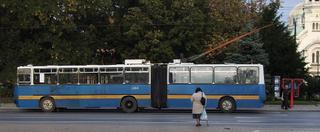Exhibit 1

Exhibit 2

Exhibit 3

Exhibit 1 is a tramvie. Exhibit 2 is a trollay. Exhibit 3 is an autovbus. Excuse me for any nonstandard Cyrillic to Latin conversion, but I've yet to find a standard; I have seen my street name spelled several way in Latin characters, and the same is true going the other way: my name is spelled differently in Cyrillic on different documents.
Anyway, how would you describe to someone what a Trollay is? Obviously, most of us would just say it is an electric bus, or more precisely, an autovbus that happens to run on electricity supplied by overhead lines. Not Bulgarians though, they describe it as “like a Tramvie, but with rubber wheels.” Now, I understand (and—as a train and electrical geek—appreciate) the infrastructure similarities, namely that you have to provide electrical current along the entire route, and therefore it takes a great deal of effort to change or enlarge the route, and they both have electric motors attached to their drive axel instead of a diesel engine somewhere. However, from the consumer point of view, there is no difference between a trollay and (city transit) autovbus! Although an autovbus could go anywhere, they always follow a set route and come by every x minutes. Therefore, I must assume that at some point in history the trollay must have looked more like a tramvie than a bus. However, I get the same result when I ask young people; this goes to show language imbeds deeper meaning than one would expect.
By the way, I've ridden every form of public transportation now, and they can all be characterized as crowded, smelly, and in need of repair; but hey, it's all part of the adventure!
No comments:
Post a Comment